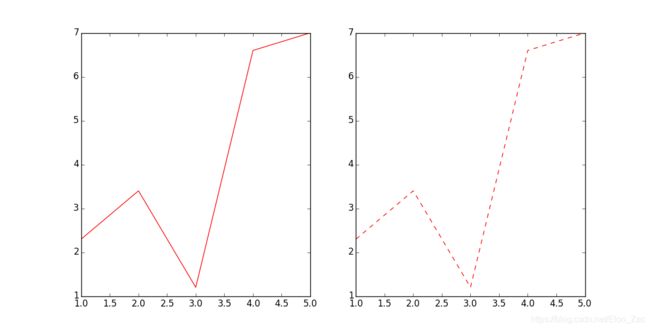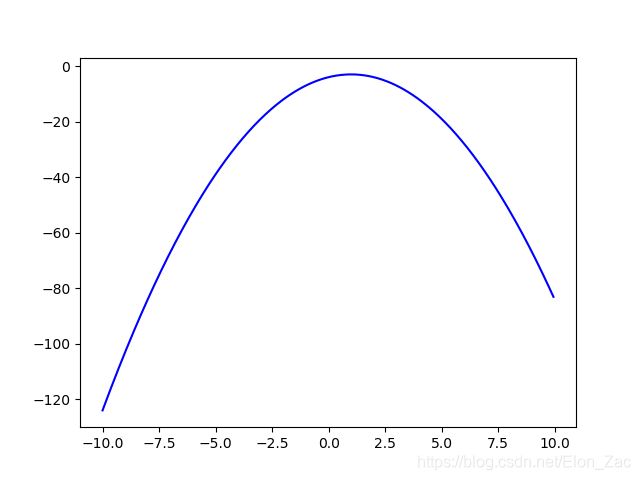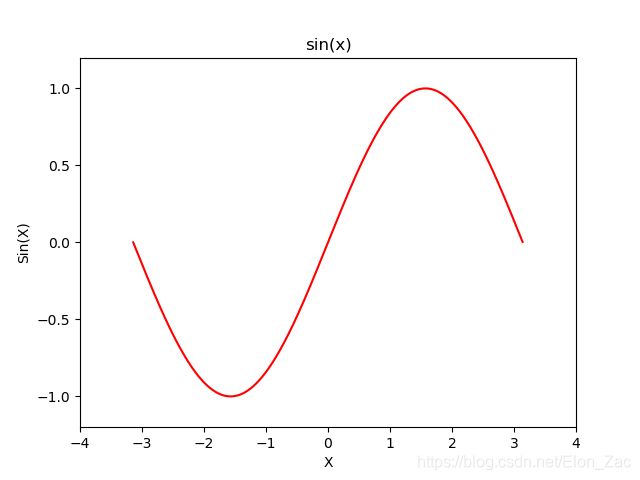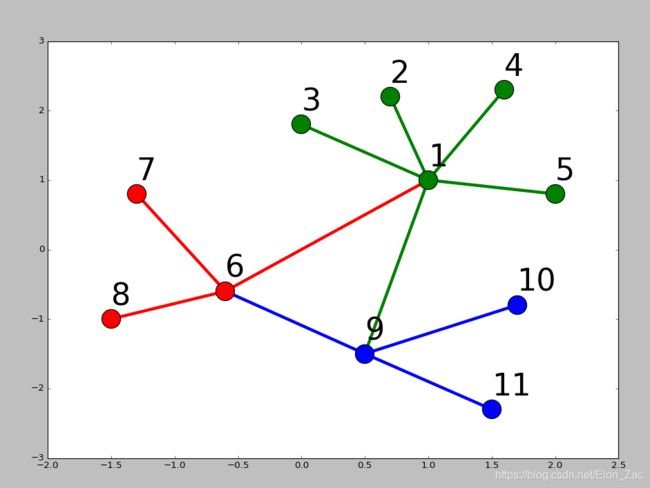Python画图matplotlib库的使用scatter(),plot()方法教学实例
Python画图主要用到matplotlib这个库。scatter和 plot 函数最常用
这个函数几乎可以调节图的一切属性,包括但不限于:坐标范围,axes标签字号大小,xtick,ytick标签字号,图线宽,legend字号等。
具体参数参看官方文档:http://matplotlib.org/users/customizing.html
scatter和 plot 函数的不同之处
scatter才是离散点的绘制程序,scatter/scatter3做散点的能力更强,因为他可以对散点进行单独设置
plot准确来说是绘制线图的,当然也可以画离散点。plt.ion()用于连续显示。
plot the real data
首先在python中使用任何第三方库时,都必须先将其引入。即:
import matplotlib.pyplot as plt 或者:from matplotlib.pyplot import
import matplotlib.pyplot as plt
fig = plt.figure() #1.建立空白图
#也可以指定所建立图的大小
#fig = plt.figure(figsize=(4,2))
#也可以建立一个包含多个子图的图,使用语句:
plt.figure(figsize=(12,6))
plt.subplot(231)
plt.subplot(2,3,2)
plt.subplot(233)
plt.subplot(234)
plt.subplot(235)
plt.subplot(236)
plt.show()

其中subplot()函数中的三个数字,第一个表示Y轴方向的子图个数,第二个表示X轴方向的子图个数,第三个则表示当前要画图的焦点。
当然上述写法并不是唯一的,比如我们也可以这样写:
import matplotlib.pyplot as plt
fig = plt.figure(figsize=(6, 6))
ax1 = fig.add_subplot(221)
ax2 = fig.add_subplot(222)
ax3 = fig.add_subplot(223)
ax4 = fig.add_subplot(224)
plt.show()
plt.subplot(111)和plt.subplot(1,1,1)是等价的。意思是将区域分成1行1列,当前画的是第一个图(排序由行至列)。
plt.subplot(211)意思就是将区域分成2行1列,当前画的是第一个图(第一行,第一列)。以此类推,只要不超过10,逗号就可省去。
可以看到图中的x,y轴坐标都是从0到1,当然有时候我们需要其他的坐标起始值。
此时可以使用语句指定:
ax1.axis([-1, 1, -1, 1])
或者:
plt.axis([-1, 1, -1, 1])
效果如下:
2.向空白图中添加内容,想你所想,画你所想
A.画散点图*
import matplotlib.pyplot as plt
#首先给出一组数据:
x = [1, 2, 3, 4, 5]
y = [2.3, 3.4, 1.2, 6.6, 7.0]
#A.画散点图*
plt.scatter(x, y, color='r', marker='+')
plt.show()
这里的参数意义:
x为横坐标向量,y为纵坐标向量,x,y的长度必须一致。
控制颜色:color为散点的颜色标志,常用color的表示如下:
b---blue c---cyan g---green k----black
m---magenta r---red w---white y----yellow
有四种表示颜色的方式:
用全名
16进制,如:#FF00FF
灰度强度,如:‘0.7’
控制标记风格:marker为散点的标记,标记风格有多种:
. Point marker
, Pixel marker
o Circle marker
v Triangle down marker
^ Triangle up marker
< Triangle left marker
> Triangle right marker
1 Tripod down marker
2 Tripod up marker
3 Tripod left marker
4 Tripod right marker
s Square marker
p Pentagon marker
* Star marker
h Hexagon marker
H Rotated hexagon D Diamond marker
d Thin diamond marker
| Vertical line (vlinesymbol) marker
_ Horizontal line (hline symbol) marker
+ Plus marker
x Cross (x) marker
B.函数图(折线图)
import matplotlib.pyplot as plt
x = [1, 2, 3, 4, 5]
y = [2.3, 3.4, 1.2, 6.6, 7.0]
fig = plt.figure(figsize=(12, 6))
plt.subplot(121)
plt.plot(x, y, color='r', linestyle='-')
plt.subplot(122)
plt.plot(x, y, color='r', linestyle='--')
plt.show()
这里有一个新的参数linestyle,控制的是线型的格式:符号和线型之间的对应关系
-
实线
– 短线
-. 短点相间线
: 虚点线
另外除了给出数据画图之外,我们也可以利用函数表达式进行画图,例如:y=sin(x)
from math import *
from numpy import *
x = arange(-2*math.pi, 2*math.pi, 0.03)
y = [sin(i) for i in x]
plt.figure()
plt.plot(x, y, color='m', linestyle='--')
plt.show()
效果如下: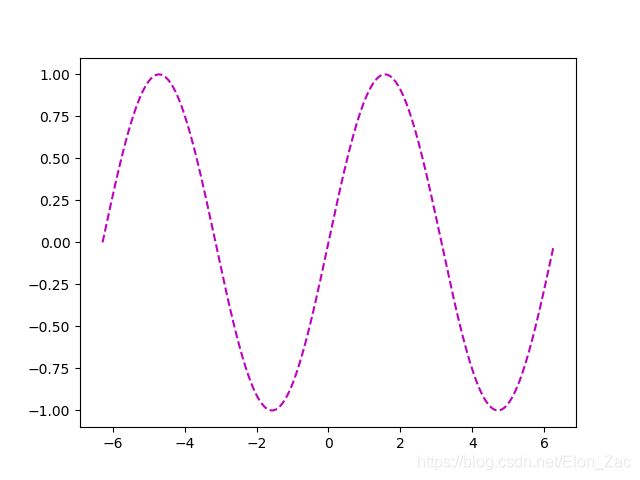 函数图抛物线 y= -xx + 2x - 4
函数图抛物线 y= -xx + 2x - 4
#‘’'画函数图抛物线
from numpy import *
x= arange(-10,10,0.05)
y= -x*x + 2*x - 4
plt.figure()
plt.plot(x,y,color='b',linestyle='-')
plt.show()
C.扇形图
示例:
import matplotlib.pyplot as plt
y = [2,2, 2,6, 12]
plt.figure()
plt.pie(y)
plt.title('Circle')
plt.show()
D.柱状图bar
示例:
import matplotlib.pyplot as plt
x = [1, 2, 3, 4, 5]
y = [2.3, 3.4, 1.2, 6.6, 7.0]
plt.figure()
plt.bar(x, y)
plt.title("bar")
plt.show()
E.二维图形(本地图片等)
import matplotlib.pyplot as plt
import numpy as np
import matplotlib.image as mpimg
import matplotlib.pyplot as plt
import matplotlib.image as mpimg #打开image包
img=mpimg.imread('1234.png') #读取相对路径文件的图片
plt.subplot() #打开画布
plt.imshow(img) #显示图片
plt.title("bear") #加入标题
plt.show()
plt.savefig("bear.pdf") #将图片保存为pdf文件
F.对所画图进行补充参数的修改
__author__ = 'zac'
#'''图表参数的修改
import matplotlib.pyplot as plt
from math import *
from numpy import *
x = arange(-math.pi, math.pi, 0.01)
y = [sin(i) for i in x]
plt.figure()
plt.plot(x, y, color='r', linestyle='-')
plt.axis([-4, 4, -1.2, 1.2])#设置坐标区间
plt.xlabel(u'X')#fill the meaning of X axis
plt.ylabel(u'Sin(X)')#fill the meaning of Y axis
plt.title(u'sin(x)')#add the title of the figure
plt.show()
#'''
G画网络图,要用到networkx这个库,下面给出一个实例:
import networkx as nx
import pylab as plt
g = nx.Graph()
g.add_edge(1,2,weight = 4)
g.add_edge(1,3,weight = 7)
g.add_edge(1,4,weight = 8)
g.add_edge(1,5,weight = 3)
g.add_edge(1,9,weight = 3)
g.add_edge(1,6,weight = 6)
g.add_edge(6,7,weight = 7)
g.add_edge(6,8,weight = 7)
g.add_edge(6,9,weight = 6)
g.add_edge(9,10,weight = 7)
g.add_edge(9,11,weight = 6)
fixed_pos = {1:(1,1),2:(0.7,2.2),3:(0,1.8),4:(1.6,2.3),5:(2,0.8),6:(-0.6,-0.6),7:(-1.3,0.8), 8:(-1.5,-1), 9:(0.5,-1.5), 10:(1.7,-0.8), 11:(1.5,-2.3)} #set fixed layout location
#pos=nx.spring_layout(g) # or you can use other layout set in the module
nx.draw_networkx_nodes(g,pos = fixed_pos,nodelist=[1,2,3,4,5],
node_color = 'g',node_size = 600)
nx.draw_networkx_edges(g,pos = fixed_pos,edgelist=[(1,2),(1,3),(1,4),(1,5),(1,9)],edge_color='g',width = [4.0,4.0,4.0,4.0,4.0],label = [1,2,3,4,5],node_size = 600)
nx.draw_networkx_nodes(g,pos = fixed_pos,nodelist=[6,7,8],
node_color = 'r',node_size = 600)
nx.draw_networkx_edges(g,pos = fixed_pos,edgelist=[(6,7),(6,8),(1,6)],width = [4.0,4.0,4.0],edge_color='r',node_size = 600)
nx.draw_networkx_nodes(g,pos = fixed_pos,nodelist=[9,10,11],
node_color = 'b',node_size = 600)
nx.draw_networkx_edges(g,pos = fixed_pos,edgelist=[(6,9),(9,10),(9,11)],width = [4.0,4.0,4.0],edge_color='b',node_size = 600)
plt.text(fixed_pos[1][0],fixed_pos[1][1]+0.2, s = '1',fontsize = 40)
plt.text(fixed_pos[2][0],fixed_pos[2][1]+0.2, s = '2',fontsize = 40)
plt.text(fixed_pos[3][0],fixed_pos[3][1]+0.2, s = '3',fontsize = 40)
plt.text(fixed_pos[4][0],fixed_pos[4][1]+0.2, s = '4',fontsize = 40)
plt.text(fixed_pos[5][0],fixed_pos[5][1]+0.2, s = '5',fontsize = 40)
plt.text(fixed_pos[6][0],fixed_pos[6][1]+0.2, s = '6',fontsize = 40)
plt.text(fixed_pos[7][0],fixed_pos[7][1]+0.2, s = '7',fontsize = 40)
plt.text(fixed_pos[8][0],fixed_pos[8][1]+0.2, s = '8',fontsize = 40)
plt.text(fixed_pos[9][0],fixed_pos[9][1]+0.2, s = '9',fontsize = 40)
plt.text(fixed_pos[10][0],fixed_pos[10][1]+0.2, s = '10',fontsize = 40)
plt.text(fixed_pos[11][0],fixed_pos[11][1]+0.2, s = '11',fontsize = 40)
plt.show()

